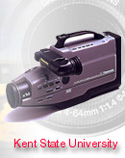

This project has an audio track. You will need to use a headset to keep your audio from disturbing others in the lab.
The purpose of this project is to give you some practice in continuity editing. As you work on this project, you will need to edit the video in such a way as to avoid jump cuts and provide the illusion of continuous action.
The video for this project was recorded at KSU’s Liquid Crystal Institute. Mark Bartlebaugh, a recent graduate of the School of Journalism and Mass Communication, recorded the audio.
Project Directions
Remember, always begin your nonlinear editing work sessions by closing other applications and documents left open by previous computer lab users. Always check that Virtual Memory has been turned off (Apple logo>Control Panel>Memory).
1. Copy the lci folder from your class CD to the computer’s hard drive. Remove your CD.
2. Start Premiere. In the New Project Setting dialog box, choose
- Editing Mode>QuickTime
- Timebase>30
Click Next to display video settings and choose
- Frame Size>240x180
- Frame Rate>15
Click OK to close the dialog box.
Choose File>New>Project.
3. Import the entire contents of the lci folder into this project.
4. Save the project with the name lci.ppj.
5. Copy the narration clip to Audio Track 1.
6. Following the script for Project C, which you will find at the end of these directions, locate the points in the audio track where the scenes change. Mark these points with markers as follows:
Double-click on the audio clip in the Timeline to open it. Go to the time location where you want to set the first marker (between scenes 1 and 2). From the Menu Bar, choose Clip>Set Marker, and choose the marker you want to add from the Set Marker menu. Repeat for all the scene changes.
If you accidentally set a marker in the wrong place, delete the marker by going to the marker and choosing Clip>Marker>Clear Marker.
7. Edit the video clips to match the audio as specified in the script. For scenes 1, 2 and 5, you will have only one shot per scene. In the other scenes, you will use two or three clips in one scene. You may put these multiple clips in any order in the scene, but be sure to use the principles of continuity editing to avoid jump cuts. Some strategies you may use are enter-and-leave, changing shot sizes and angles, and matching action.
8.When your movie is finished, export it with these steps:
Click in the Timeline window to select it.
Choose File>Export>Movie.
In the Export Movie dialog box, click the Settings button.
Choose File Type>QuickTime and Range>Entire Project. Make sure both Export Video and Export Audio are selected.
Click OK to close the Export Movie Settings dialog box.
In the Export Movie dialog box, type lci.mov for the name of the program. Click OK.
9. When the movie is rendered, view it to check for errors. If necessary, make corrections. If the movie is completed the way you want it, save it for grading as follows:
Insert your Zip disk.
Double-click its icon to check the disk’s contents. Make sure you have at least 50 MB of storage space available on the disk. If not, delete files from the disk by dragging those files to Trash. (Before you do this, make sure these files are ones you don’t mind losing.)
Copy your files lci.ppj and lci.mov to your Zip disk.
Make absolutely sure the files have copied correctly.
Remove the Zip disk from the computer. Check to see that you have labeled both the disk and its case with your name. Turn it in for grading.
10. Finish your lab session as follows:
Quit the Premiere program.
Drag the lci folder from the hard drive to the Trash.
Empty the Trash. This step permanently eliminates the work you have done this session, so it’s important to perform the step of saving to the Zip disk accurately.
Put the computer into the sleep mode.
Project C Script: Academic Programs at LCI
Scene 1: building.bmp
Narrator: Kent State University’s Liquid Crystal Institute is the largest academic center devoted to liquid crystal research.
Scene 2: class.mov
Narrator: It’s the home of the Chemical Physics Interdisciplinary Program—the only graduate program of this kind in the country.
Scene 3: micro1.mov and micro2.mov
Narrator: The C-P-I-P combines courses in Physics, Chemistry and Math, focused on the study of liquid crystals. The program leads to an M.S. or Ph.D. degree in chemical physics with a choice of concentrations.
Scene 4: demo1.mov and demo2.mov
Narrator: Graduate students in this program participate in basic and applied research. They work with the faculty and research staff to create new liquid crystal materials, to study physical and optical properties of liquid crystals, and to develop new display devices.
Scene 5: observe.mov
Narrator: Students in the Chemical Physics Interdisciplinary Program have opportunities to collaborate with scientists around the world and to work on projects for leading companies in the communications industry.
Scene 6: gloves1.mov, gloves2.mov and gloves3.mov
Narrator: For students who just can’t wait until their graduate studies to start investigating liquid crystals, there’s the Summer Undergraduate Research Program. Each summer the Liquid Crystal Institute hires several undergraduates from various disciplines to work in the research labs on both basic and applied research projects.
Home Page | Assignments | Syllabus | Instructor | JMC Web Site